Geochemistry of Middle Jurassic Coals from the Dananhu Mine, Xinjiang: Emphasis on Sediment Source and Control Factors of Critical Metals
Abstract
:1. Introduction
2. Geological Setting
3. Samples and Analytic Methods
4. Results
4.1. Coal Chemistry
4.2. Maceral and Minerals
4.3. Major Element Oxides in Raw Coal
4.4. Trace Element in Raw Coal
4.5. Rare Earth Element (REY)
4.5.1. Concentration, Enrichment, and Vertical Variation of REY
4.5.2. Geochemical Parameters and Distribution Patterns of REY
5. Discussion
5.1. Evaluation of Critical Metal Elements
5.2. Sedimentary Source Region
5.3. Depositional Environment
5.4. Reasons for Low Elemental Contents in the Dananhu Coals
6. Conclusions
- 1.
- The Dananhu coals are characterized by a low ash yield, low total sulfur content, and high volatile yield. The inertinite is the most abundant maceral, followed by vitrinite, and the liptinite is less. Quartz, kaolinite, and illite are the main minerals. In addition, there are small amounts of calcite, chalcopyrite, anatase, and zircon.
- 2.
- Compared with the world’s low-rank coals, Ni, Co, Mo, and Ta are slightly enriched, and Li, Rb, Cs, Ba, Tl, Bi, Ge, and other elements are depleted. The content of other trace elements is equivalent to the average values of the world’s low-rank coals. The REY of the Dananhu coals shows high fractionation, mainly H-type- and M-H-type enrichment. The concentration of critical metals (Li, Ga, Ge, Zr, Nb, Hf, Ta, etc.) in the coal ash of the Dananhu coals is heterogeneous. The content of Ga, Zr (Hf), and Nb (Ta) in the coal ash has reached the cut-off grade of industrial mining, which has the potential to become a substitute for rare metal resources, while Li, Ge, and REY elements have no potential economic mining value.
- 3.
- The sediment sources of the Dananhu coal mainly come from the Paleozoic dacite, andesite, and a small amount of granite from Harlik Mountain and Eastern Bogda Mountain in the Turpan-Hami Basin. The Dananhu coals are generally in a dry and hot depositional environment with high salinity and weak reduction oxidation. Low source input and a weak reduction-oxidation environment have led to a low concentration of critical metal elements in the Dananhu coals.
Supplementary Materials
Author Contributions
Funding
Data Availability Statement
Acknowledgments
Conflicts of Interest
References
- Dai, S.; Zhao, L.; Wei, Q.; Song, X.; Wang, W.; Liu, J.; Duan, P. Resources of critical metals in coal-bearing sequences in China: Enrichment types and distribution. Chin. Sci. Bull. 2020, 65, 3715–3729, (In Chinese with English abstract). [Google Scholar] [CrossRef]
- Ministry of Natural Resources of the People’s Republic of China. China Mineral Resources 2023, 6–9, Beijing, China. 2023. Available online: https://www.mnr.gov.cn/ (accessed on 26 October 2023). (In Chinese)
- Seredin, V.V.; Dai, S.; Sun, Y.; Chekryzhov, I.Y. Coal deposits as promising sources of rare metals for alternative power and energy-efficient technologies. Appl. Geochem. 2013, 31, 1–11. [Google Scholar] [CrossRef]
- Dai, S.; Finkelman, R.B.; French, D.; Hower, J.C.; Graham, I.T.; Zhao, F. Modes of occurrence of elements in coal: A critical evaluation. Earth-Sci. Rev. 2021, 222, 103815. [Google Scholar]
- Sun, Y.; Zhao, C.; Li, Y.; Wang, J.; Liu, S. Li distribution and mode of occurrences in Li-bearing coal seam #6 from the Guanbanwusu mine, Inner Mongolia, northern China. Energy Explor. Exploit. 2012, 30, 109–130. [Google Scholar]
- Dai, S.; Ren, D.; Chou, C.-L.; Finkelman, R.B.; Seredin, V.V.; Zhou, Y. Geochemistry of trace elements in Chinese coals: A review of abundances, genetic types, impacts on human health, and industrial utilization. Int. J. Coal Geol. 2012, 94, 3–21. [Google Scholar] [CrossRef]
- Yudovich, Y.E.; Ketris, M.P. Selenium in coal: A review. Int. J. Coal Geol. 2006, 67, 112–126. [Google Scholar] [CrossRef]
- Seredin, V.V.; Finkelman, R.B. Metalliferous coals: A review of the main genetic and geochemical types. Int. J. Coal Geol. 2008, 76, 253–289. [Google Scholar] [CrossRef]
- Dai, S.; Wang, P.; Ward, C.R.; Tang, Y.; Song, X.; Jiang, J.; Hower, J.C.; Li, T.; Seredin, V.V.; Wagner, N.J.; et al. Elemental and mineralogical anomalies in the coal-hosted Ge ore deposit of Lincang, Yunnan, southwestern China: Key role of N2-CO2-mixed hydrothermal solutions. Int. J. Coal Geol. 2015, 152, 19–46. [Google Scholar] [CrossRef]
- Dai, S.; Chekryzhov, I.Y.; Seredin, V.V.; Nechaev, V.P.; Graham, I.T.; Hower, J.C.; Ward, C.R.; Ren, D.; Wang, X. Metalliferous coal deposits in East Asia (Primorye of Russia and South China): A review of geodynamic controls and styles of mineralization. Gondwana Res. 2016, 29, 60–82. [Google Scholar] [CrossRef]
- Dai, S.; Jiang, Y.; Ward, C.R.; Gu, L.; Seredin, V.V.; Liu, H.; Zhou, D.; Wang, X.; Sun, Y.; Zou, J.; et al. Mineralogical and geochemical compositions of the coal in the Guanbanwusu mine, Inner Mongolia, China: Further evidence for the existence of an Al (Ga and REE) ore deposit in the Jungar coalfield. Int. J. Coal Geol. 2012, 98, 10–40. [Google Scholar] [CrossRef]
- Dai, S.; Wang, X.; Seredin, V.V.; Hower, J.C.; Ward, C.R.; O’Keefe, J.M.K.; Huang, W.; Li, T.; Li, X.; Liu, H.; et al. Petrology, mineralogy, and geochemistry of the Ge-rich coal from the Wulantuga Ge ore deposit, Inner Mongolia, China: New data and genetic implications. Int. J. Coal Geol. 2012, 90–91, 72–99. [Google Scholar] [CrossRef]
- Dai, S.; Li, D.; Chou, C.-L.; Zhao, L.; Zhang, Y.; Ren, D.; Ma, Y.; Su, Y. Mineralogy and geochemistry of boehmite-rich coals: New insights from the Haerwusu Surface Mine, Jungar Coalfield, Inner Mongolia, China. Int. J. Coal Geol. 2008, 74, 185–202. [Google Scholar] [CrossRef]
- Cao, D.; Shao, L.; Zhang, P. Palaeotectonics in The Early and Middle Jurassic Coal-Forming Periods of the Turpan-Hami Basin. J. Palaeogeogr. 1999, 2, 46–52. (In Chinese) [Google Scholar]
- Graham, S. Sedimentary record of Mesozoic deformation and inception of the Turpan-Hami basin, northwest China. In Paleozoic and Mesozoic Tectonic Evolution of Central and Eastern Asia; Geological Society of America: Boulder, CO, USA, 2001; Volume 194, p. 317. [Google Scholar]
- Wartes, M.A.; Carroll, A.R.; Greene, T.J. Permian sedimentary record of the Turpan-Hami basin and adjacent regions, northwest China: Constraints on postamalgamation tectonic evolution. Geol. Soc. Am. Bull. 2002, 114, 131–152. [Google Scholar] [CrossRef]
- Shao, L.; Stattegger, K.; Garbe-Schoenberg, C.D. Sandstone Petrology and Geochemistry of the Turpan Basin (NW China): Implications for the Tectonic Evolution of a Continental Basin. J. Sediment. Res. 2001, 71, 37–49. [Google Scholar] [CrossRef]
- Shao, L.; Zhang, P.; Hilton, J.; Gayer, R.; Wang, Y.; Zhao, C.; Luo, Z. Paleoenvironments and palaeogeography of the Lower and lower Middle Jurassic coal measures in the Turpan-Hami oil-prone coal basin, northwestern China. AAPG Bull. 2003, 87, 335–355. [Google Scholar] [CrossRef]
- Shen, T.; Chen, Y.; Wang, G.; Ji, J.; Wang, Y.; Zhang, P.; Sotirious, P.; Guo, R.; Xu, Z. Detrital zircon geochronology analysis of the Late Mesozoic deposition in the Turpan-Hami basin: Implications for the uplift history of the Eastern Tian Shan, north-western China. Terra Nova 2020, 32, 166–178. [Google Scholar] [CrossRef]
- Qin, Y.; Liu, C.; Yang, L.; Peng, H.; Jiao, X. Detrital-Zircon Geochronology of Jurassic–Cretaceous Strata in the Turpan-Hami Basin: Implication for the Late Mesozoic Tectonic Evolution of Eastern Tien Shan. Minerals 2022, 12, 926. [Google Scholar] [CrossRef]
- Li, Y.; Kang, Y. Analysis of major controlling geological factors on coalbed methane enrichment and accumulation model of low coal rank in Tuha-Santanghu Basin. In IOP Conference Series: Materials Science and Engineering; IOP Publishing: Bristol, UK, 2020; Volume 780. [Google Scholar]
- Wang, W.; Li, T.; Xiao, D.; Wang, B.; Yang, Y.; Zhang, Y.; La, W.; He, J. Geological conditions and controls on accumulation of tight sandstone gas, deep part of the Shengbei sub-sag, Turpan-Hami basin, NW China. Mar. Pet. Geol. 2023, 158, 106513. [Google Scholar] [CrossRef]
- Sun, Q. Sedimentary environment and coal aggregation law in the detailed investigation area of the Dananhu coal field in Hami City, Xinjiang. Inn. Mong. Coal Econ. 2018, 11, 159–160. (In Chinese) [Google Scholar]
- Cui, C. Comparative characteristics of coal seams in the F1 South Shaft Field of Dannanhu Mine Area II. Sci. Technol. Eng. 2019, 19, 103–109. (In Chinese) [Google Scholar]
- Liang, K. Sedimentary environment and coal aggregation pattern in the middle section of the Xishanyao Formation in the Dananhu Coalfield, Tuha Basin. Xinjiang Geol. 2021, 39, 470–474. (In Chinese) [Google Scholar]
- Tao, M. On the two tectonic unit systems of the Tuha Basin in Xinjiang. Geol. Bull 2010, 29, 297–304. (In Chinese) [Google Scholar]
- GB/T 482-2008; Sampling of Coal Seams. Standard Press of China: Beijing, China, 2008. (In Chinese)
- International Committee for Coal and Organic Petrology (ICCP). The new vitrinite classification (ICCP System 1994). Fuel 1998, 77, 349–358. [Google Scholar] [CrossRef]
- International Committee for Coal and Organic Petrology (ICCP). The new inertinite classification (ICCP System 1994). Fuel 2001, 80, 459–471. [Google Scholar] [CrossRef]
- Pickel, W.; Kus, J.; Flores, D.; Kalaitzidis, S.; Christanis, K.; Cardott, B.J.; Misz-Kennan, M.; Rodrigues, S.; Hentschel, A.; Hamor-Vido, M.; et al. Classification of liptinite–ICCP System 1994. Int. J. Coal Geol. 2017, 169, 40–61. [Google Scholar] [CrossRef]
- ASTM D3173-11; Test Method for Moisture in the Analysis Sample of Coal and Coke. ASTM International: West Conshohocken, PA, USA, 2011.
- ASTM D3174-11; Annual Book of ASTM Standards. Test Method for Ash in the Analysis Sample of Coal and Coke. ASTM International: West Conshohocken, PA, USA, 2011.
- ASTM D3175-11; Test Method for Volatile Matter in the Analysis Sample of Coal and Coke. ASTM International: West Conshohocken, PA, USA, 2011.
- ASTM D3177-02; Standard Test Methods for Total Sulfur in the Analysis Sample of Coal and Coke (Withdrawn 2012). ASTM International: West Conshohocken, PA, USA, 2007.
- Taylor, J. Computer programs for standardless quantitative analysis of minerals using the full powder diffraction profile. Powder Diffr. 1991, 6, 2–9. [Google Scholar] [CrossRef]
- GB15224.1-2018; Classification for Quality of Coal-Part 1: Ash. Standard Press of China: Beijing, China, 2018. (In Chinese)
- ASTM D388-12; Standard Classification of Coals by Rank. ASTM International: West Conshohocken, PA, USA, 2012.
- Spears, D.A. Mineral matter in coals, with special reference to the Pennine Coalfields. Geol. Soc. Lond. Spec. Publ. 1987, 32, 171–185. [Google Scholar] [CrossRef]
- Dai, S.; Seredin, V.V.; Ward, C.R.; Hower, J.C.; Xing, Y.; Zhang, W.; Song, W.; Wang, P. Enrichment of U-se-mo-re-V in coals preserved within marine carbonate successions: Geochemical and mineralogical data from the late permian guiding coalfield, Guizhou, China. Mineral. Depos. 2015, 50, 159–186. [Google Scholar] [CrossRef]
- Ketris, M.P.; Yudovich, Y.E. Estimations of Clarkes for carbonaceous bioLIthes: World average for trace element contents in black shales and coals. Int. J. Coal Geol. 2009, 78, 135–148. [Google Scholar] [CrossRef]
- Wei, J.; Wei, Y.; Qin, G.; Ning, S.; Cao, D.; Wang, A. Geochemistry, Mineralogy, and Coal Petrology of No. 4 Coal in Sandaoling Mine, Turpan-Hami Basin, Northwest China: Provenance and Peat Depositional Environment. Minerals 2023, 13, 837. [Google Scholar] [CrossRef]
- Yan, X.; Dai, S.; Graham, I.T.; He, X.; Shan, K.; Liu, X. Determination of eu concentrations in coal, fly ash and sedimentary rocks using a cation exchange resin and inductively coupled plasma mass spectrometry (ICP-MS). Int. J. Coal Geol. 2018, 191, 152–156. [Google Scholar] [CrossRef]
- Seredin, V.V.; Dai, S.F. Coal deposits as potential alternative sources for lanthanides and yttrium. Int. J. Coal Geol. 2012, 94, 67–93. [Google Scholar] [CrossRef]
- Dai, S.; Graham, I.T.; Ward, C.R. A review of anomalous rare earth elements and yttrium in coal. Int. J. Coal Geol. 2016, 159, 82–95. [Google Scholar] [CrossRef]
- Lu, Q.; Qin, S.; Wang, W.; Wang, Q.; Kang, S. Geochemistry of Late Permian coals from the Yueliangtian coal deposit, Guizhou: Evidence of sediment source and evaluation on critical elements. Sci. Total Environ. 2023, 856, 159123. [Google Scholar] [CrossRef] [PubMed]
- Dai, S.; Finkelman, R.B. Coal as a promising source of critical elements: Progress and future prospects. Int. J. Coal Geol. 2018, 186, 155–164. [Google Scholar] [CrossRef]
- DZ/T 0203-2002; Geology Mineral Industry Standard of P.R. China: Specifications for Rare Metal Mineral Exploration. Geological Press: Beijing, China, 2002. (In Chinese)
- Adamczyk, Z.; Komorek, J.; Kokowska-Pawłowska, M.; Nowak, J. Distribution of Rare-Earth Elements in Ashes Produced in the Coal Combustion Process from Power Boilers. Energies 2023, 16, 2696. [Google Scholar] [CrossRef]
- Hayashi, K.I.; Fujisawa, H.; Holland, H.D.; Ohmoto, H. Geochemistry of ~1.9 Ga sedimentary rocks from northeastern Labrador, Canada. Geochim. Cosmochim. Acta 1997, 61, 4115–4137. [Google Scholar] [CrossRef]
- Dai, S.; Jiang, Y.; Ward, C.R.; Hower, J.C.; Liu, H.; Garrison, T.M.; French, D.; O’Keefe, J.M.K. Geochemical and mineralogical evidence for a coal-hosted uranium deposit in the Yili Basin, Xinjiang, northwestern China. Ore Geol. Rev. 2015, 70, 1–30. [Google Scholar] [CrossRef]
- Moradi, A.V.; Sarı, A.; Akkaya, P. Geochemistry of the Miocene oil shale (Hançili Formation) in the Çankırı-Çorum Basin, Central Turkey: Implications for Paleoclimate conditions, source–area weathering, provenance and tectonic setting. Sediment. Geol. 2016, 341, 289–303. [Google Scholar] [CrossRef]
- Cui, F.; Wang, X.; Ma, Z.; Sun, J.; Zhu, X. Comparison of Genesis of Devonian Volcanic Rocks in the Bogda and Harlik Areas and its Tectonic Implications. Geol. Explor. 2015, 51, 519–533. (In Chinese) [Google Scholar]
- Jin, L.; Zhang, J.; Zhu, Z.; Zhao, T.; Xu, S.; Li, P.; Chen, B. The Geologic Character and Tectonic Significance of Paleozoic Volcanic Rocks in the Harlik Mountains, Xinjiang. Xinjiang Geol. 2013, 31, 173–179. (In Chinese) [Google Scholar]
- Zhao, T.; Xu, S.; Zhu, Z.; Liu, X.; Chen, C. Geological and Geochemical Features of Carboniferous Volcanic Rocks in Bogda-Harlik Mountains, Xinjiang and Thire Tectonic Significances. Geol. Rev. 2014, 60, 115–127. (In Chinese) [Google Scholar]
- Song, P.; Tong, Y.; Wang, T.; Huang, H.; Zhang, J.; Huang, W. Zircon U-Pb ages, genetic evolution and geological significance of Carboniferous granites in the Harlik Mountain, East Tianshan, Xinjiang. Geol. Bull. China 2018, 37, 790–804. (In Chinese) [Google Scholar]
- Yao, Y.; Xing, W.; Jia, H.; Wang, Y.; Zhao, Z.; Ma, M.; Guo, S. Geochronology, Geochemistry and Tectonic Significance of Southern Xiamaya Granite in Harlik Area, Dongtianshan Mountain. J. Mineral. Petrol. 2020, 40, 30–43. (In Chinese) [Google Scholar]
- Wang, C.; Ma, X.; Chen, B.; Yan, X. Late Carboniferous volcanism of the Harlik orogenic belt Xinjiang: Zircon U-Pb geochronological geochemical and Sr-Nd isotopic evidence. Acta Petrol. Sin. 2017, 33, 440–454. (In Chinese) [Google Scholar]
- Wignall, P.B. Black Shales; Clarendon Press: Oxford, UK, 1994; 46p. [Google Scholar]
- Dai, S.; Bechtel, A.; Eble, C.F.; Flores, R.M.; French, D.; Graham, I.T.; Hood, M.M.; Hower, J.C.; Korasidis, V.A.; Moore, T.A.; et al. Recognition of peat depositional environments in coal. A review. Int. J. Coal Geol. 2020, 219, 103383. [Google Scholar]
- Dai, S.; Zhang, W.; Seredin, V.V.; Ward, C.R.; Hower, J.C.; Song, W.; Wang, X.; Li, X.; Zhao, L.; Kang, H.; et al. Factors controlling geochemical and mineralogical compositions of coals preserved within marine carbonate successions: A case study from the Heshan Coalfield, southern China. Int. J. Coal Geol. 2013, 109, 77–100. [Google Scholar] [CrossRef]
- Chen, J.; Chen, P.; Yao, D.X.; Liu, Z.; Wu, Y.S.; Liu, W.Z.; Hu, Y.B. Mineralogy and geochemistry of Late Permian coals from the Donglin Coal Mine in the Nantong coalfield in Chongqing, southwestern China. Int. J. Coal Geol. 2015, 149, 24–40. [Google Scholar] [CrossRef]
- Shi, Z.; Chen, K.; Shi, J.; Liu, B.; He, H.; Liu, G. Feasibility Analysis of the Application of the Ratio of Strontium to Barium on the Identifying Sedimentary Environment. Fault-Block Oil Gas Field 2003, 10, 12–16. (In Chinese) [Google Scholar]
- Deng, H.; Qin, K. Geochemical binary division Character of Lacustrine Argillite. Oil Gas Geol. 1993, 2, 85–97. (In Chinese) [Google Scholar]
- Wang, M.; Jiao, Y.; Wang, Z.; Yang, Q.; Yang, S. Recovery paleosalinity in sedimentary environment—An example of mudstone in Shuixigou group, southwestern margin of Turpan-Hami basin. Xinjiang Petroleum Geol. 2005, 26, 719, (In Chinese with English abstract). [Google Scholar]
- Wang, A.; Wang, Z.; Liu, J.; Xu, N.; Li, H. The Sr/Ba ratio response to salinity in clastic sediments of the Yangtze River Delta. Chem. Geol. 2021, 559, 119923. [Google Scholar] [CrossRef]
- Stach, E.; Mackowsky, M.T.; Teichmuller, M.; Taylor, G.H.; Chandra, D.; Teichmuller, R. Stach’s Textbook of Coalpetrology; Gebruder Borntraeger: Berlin, Germany, 1982; 535p. [Google Scholar]
- Hower, J.C.; O’Keefe, J.M.K.; Volk, T.J.; Watt, M.A. Funginite–resinite associations in coal. Int. J. Coal Geol. 2010, 83, 64–72. [Google Scholar] [CrossRef]
- Xu, F.; Fang, A. Coal facies analysis upon No.16 coal seam in Yanzhou coal mining area of Shandong Province. Coal Geol. Explor. 2005, 33, 10–13. (In Chinese) [Google Scholar]
- Ren, D.; Zhao, F.; Dai, S.; Zhang, J.; Luo, K. Geochemistry of Trace Elements in Coal; Science Press: Beijing, China, 2006; pp. 399–556, (In Chinese with English abstract). [Google Scholar]
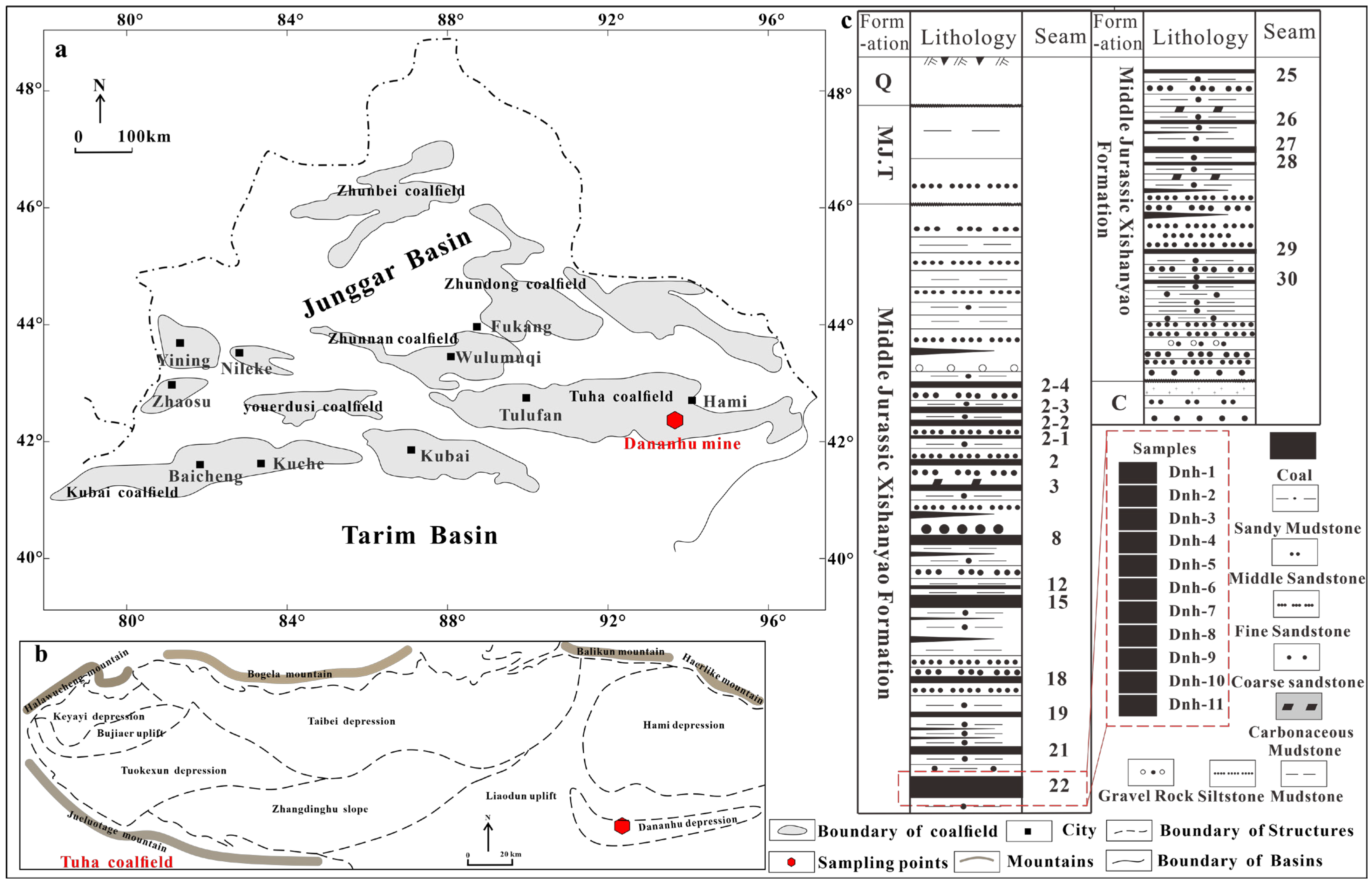
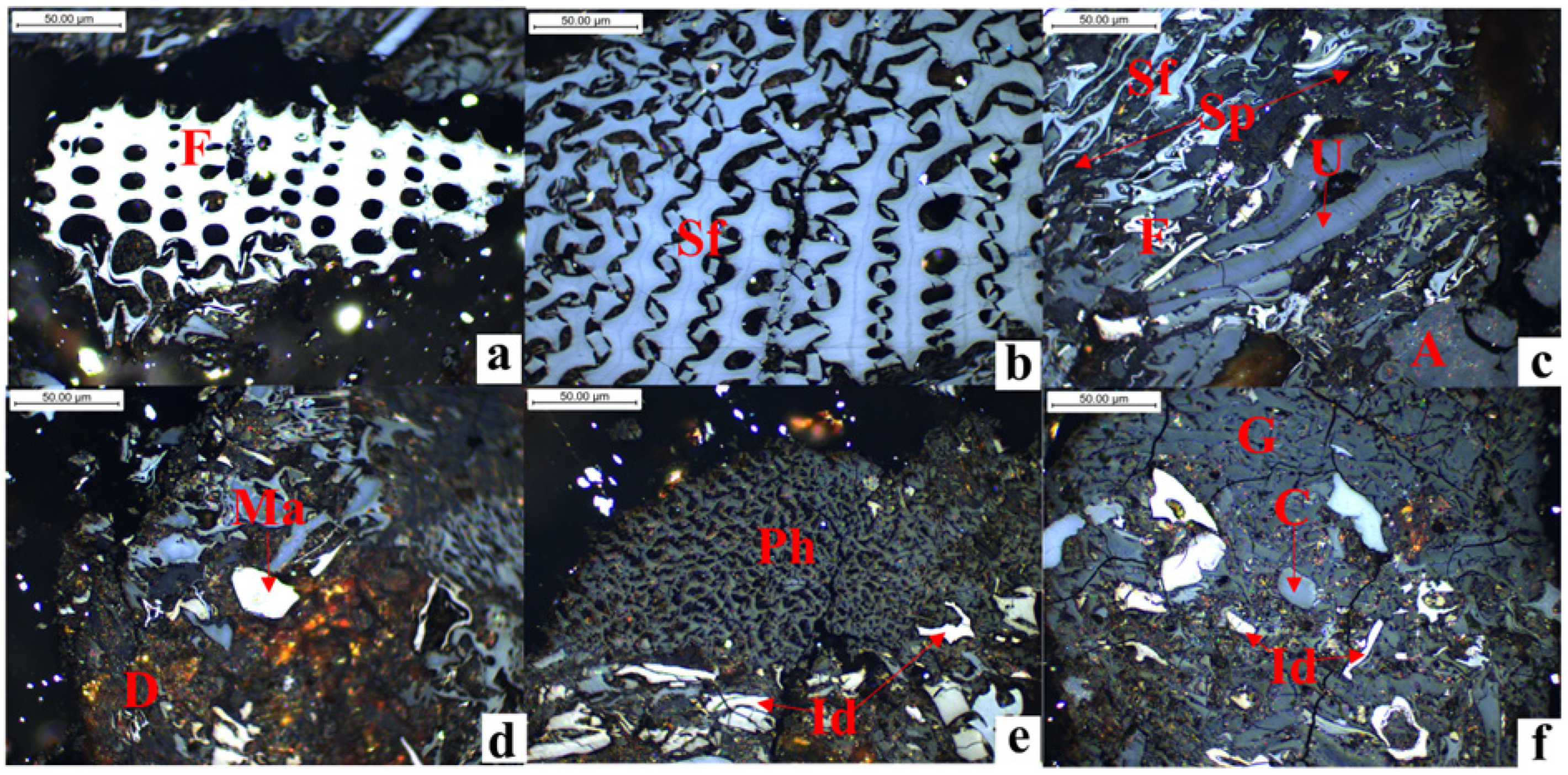
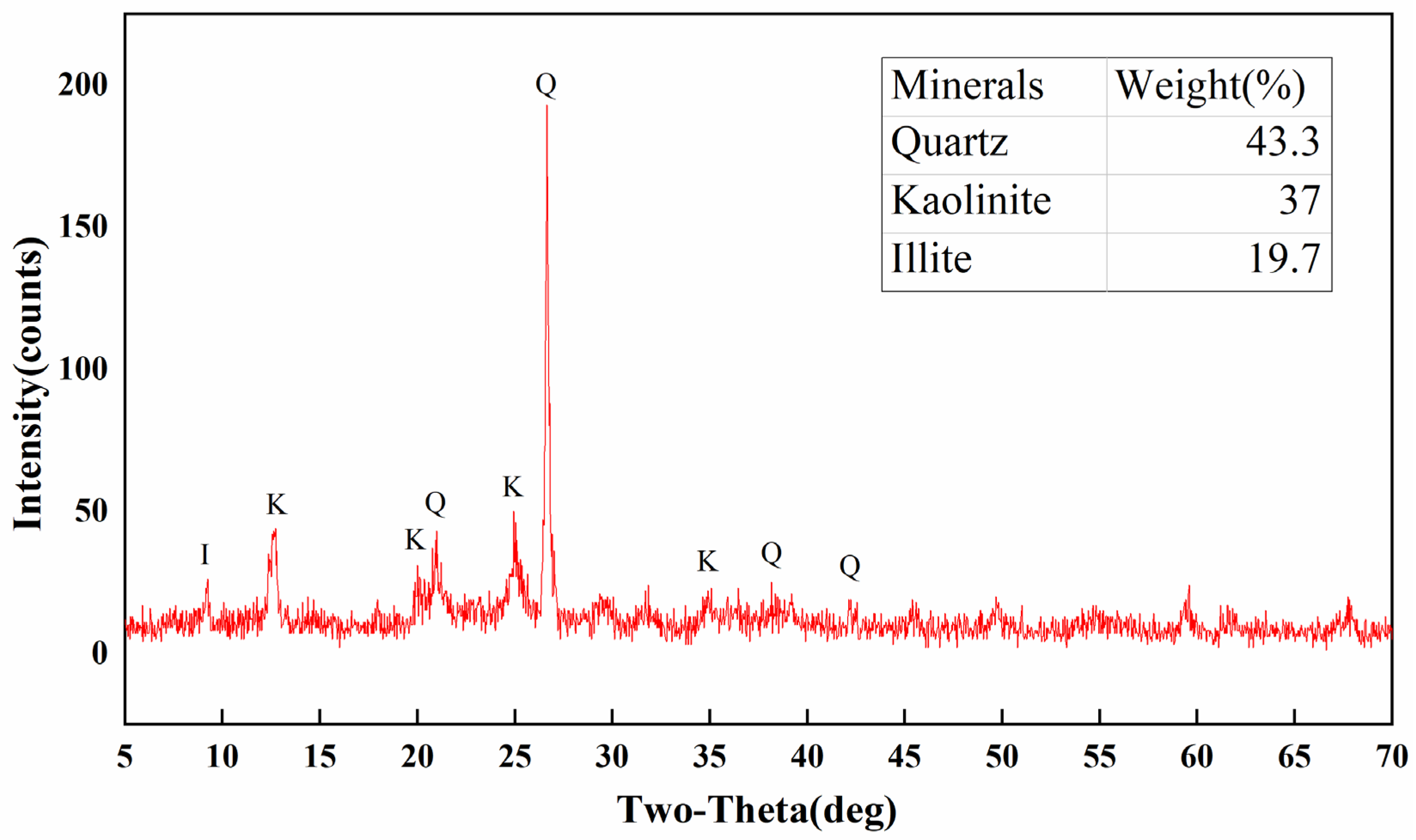


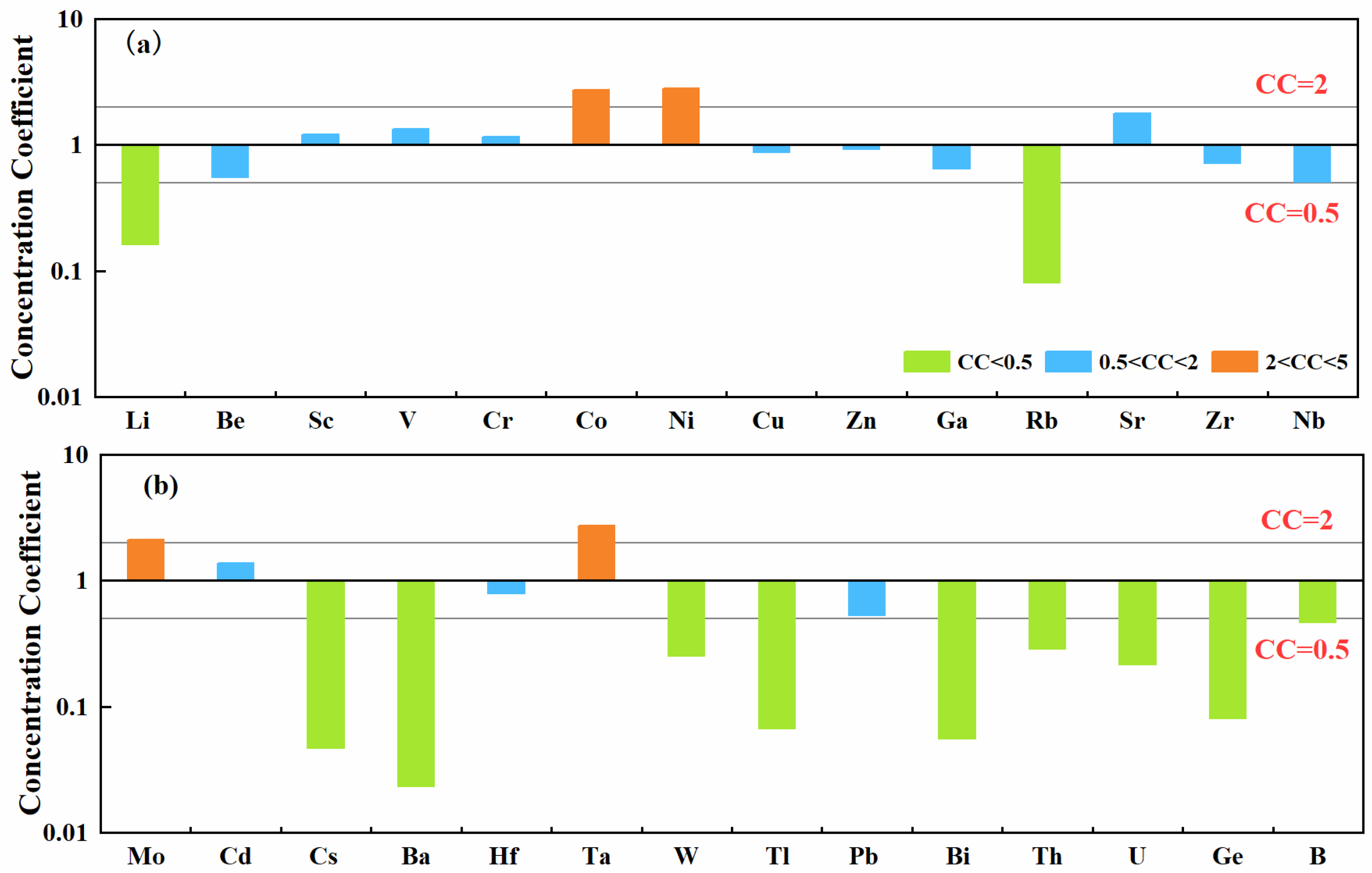

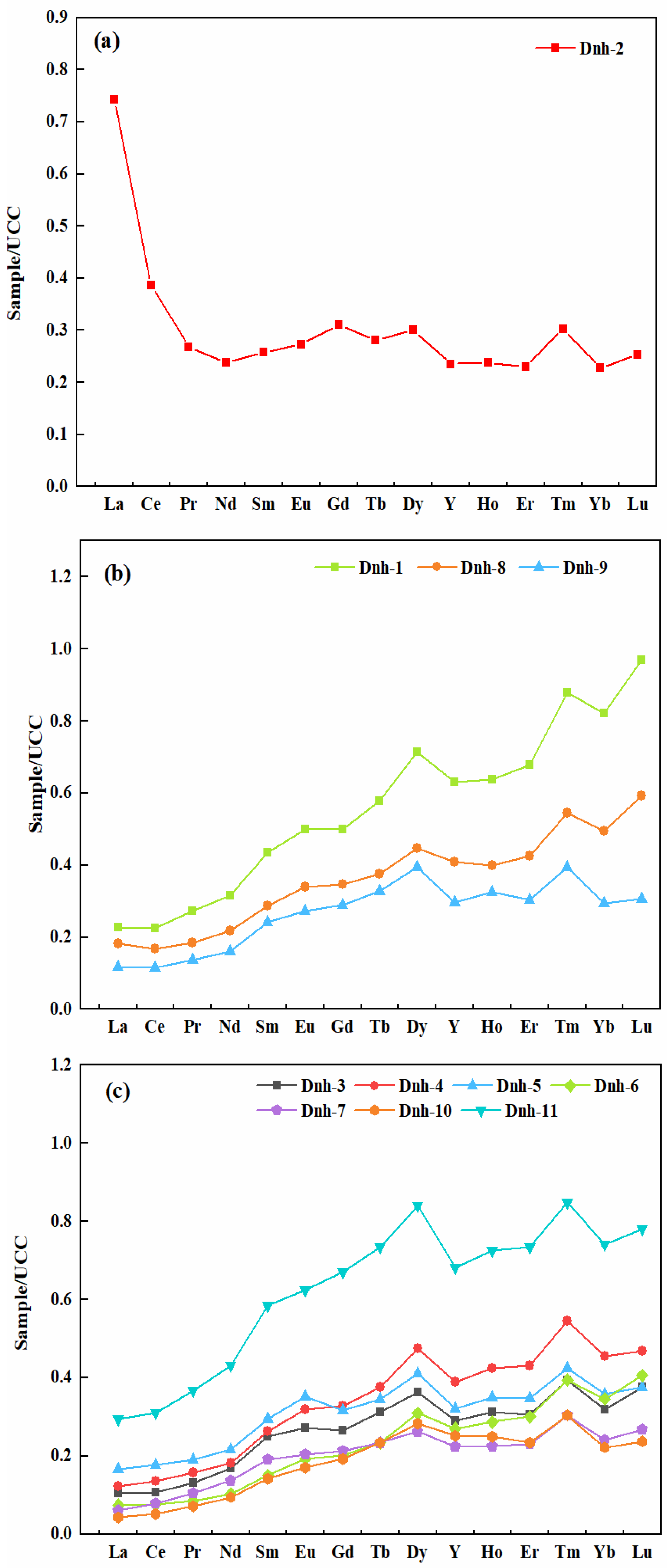
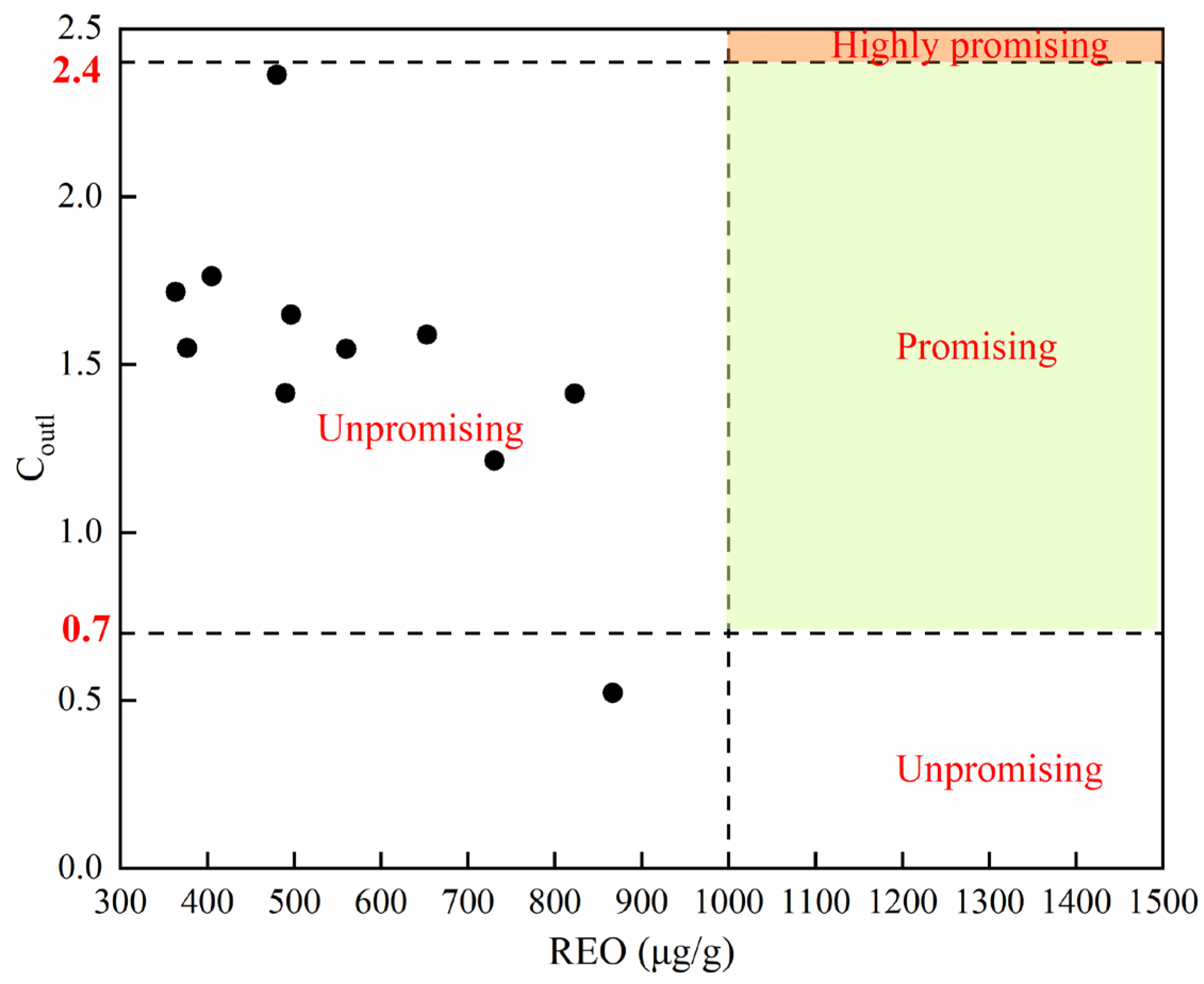

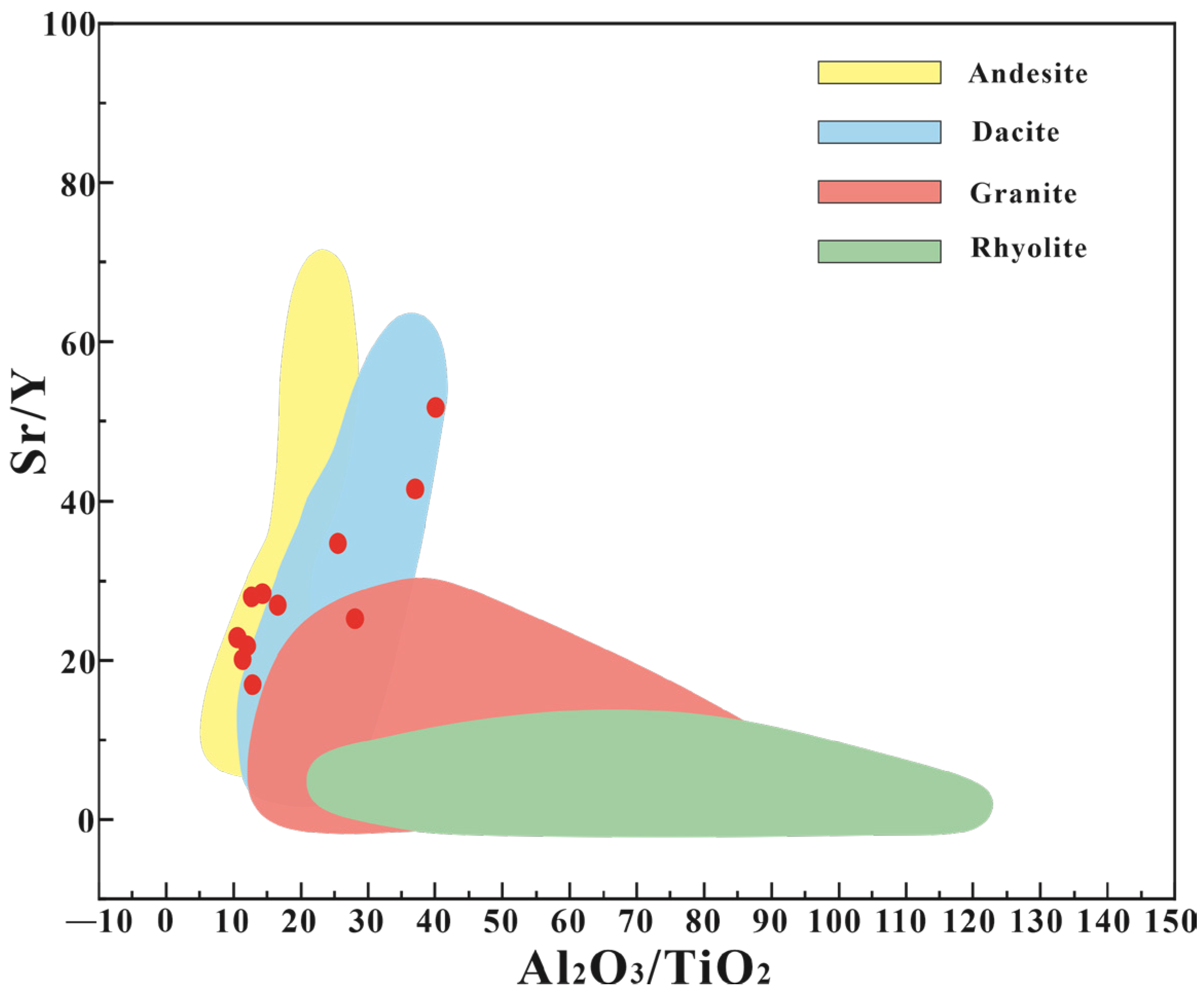
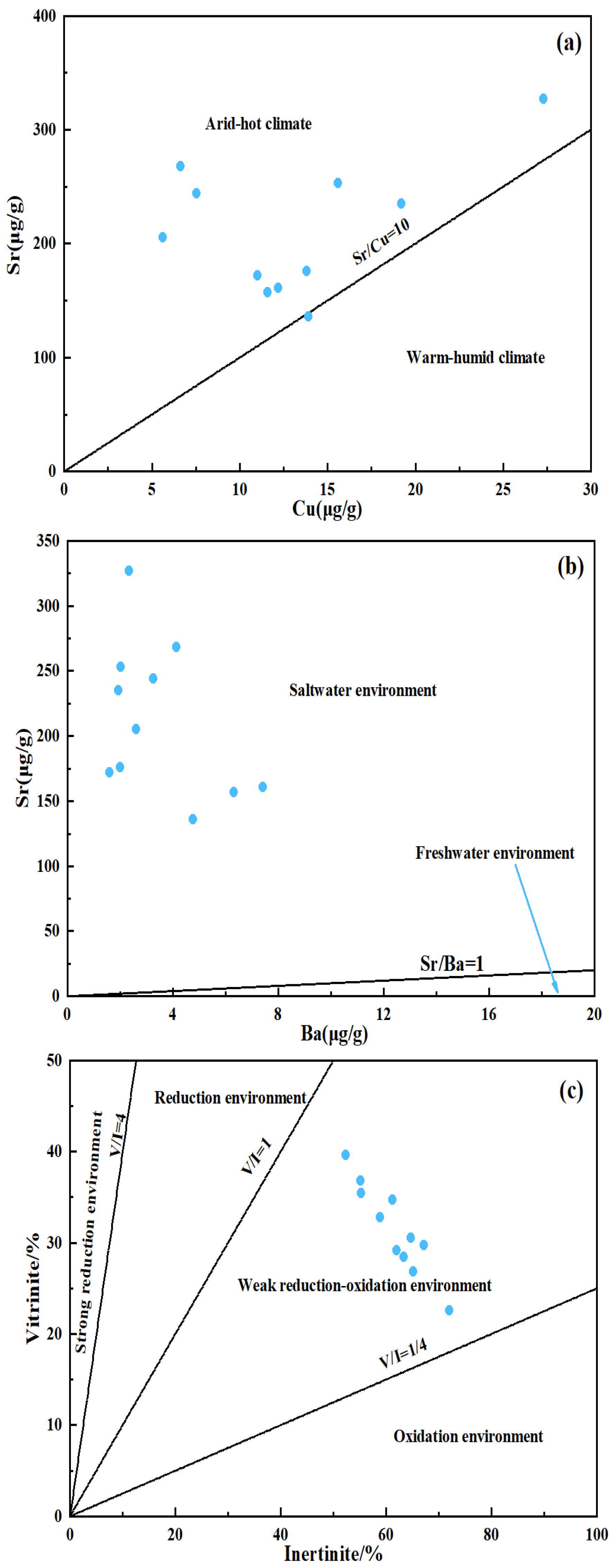
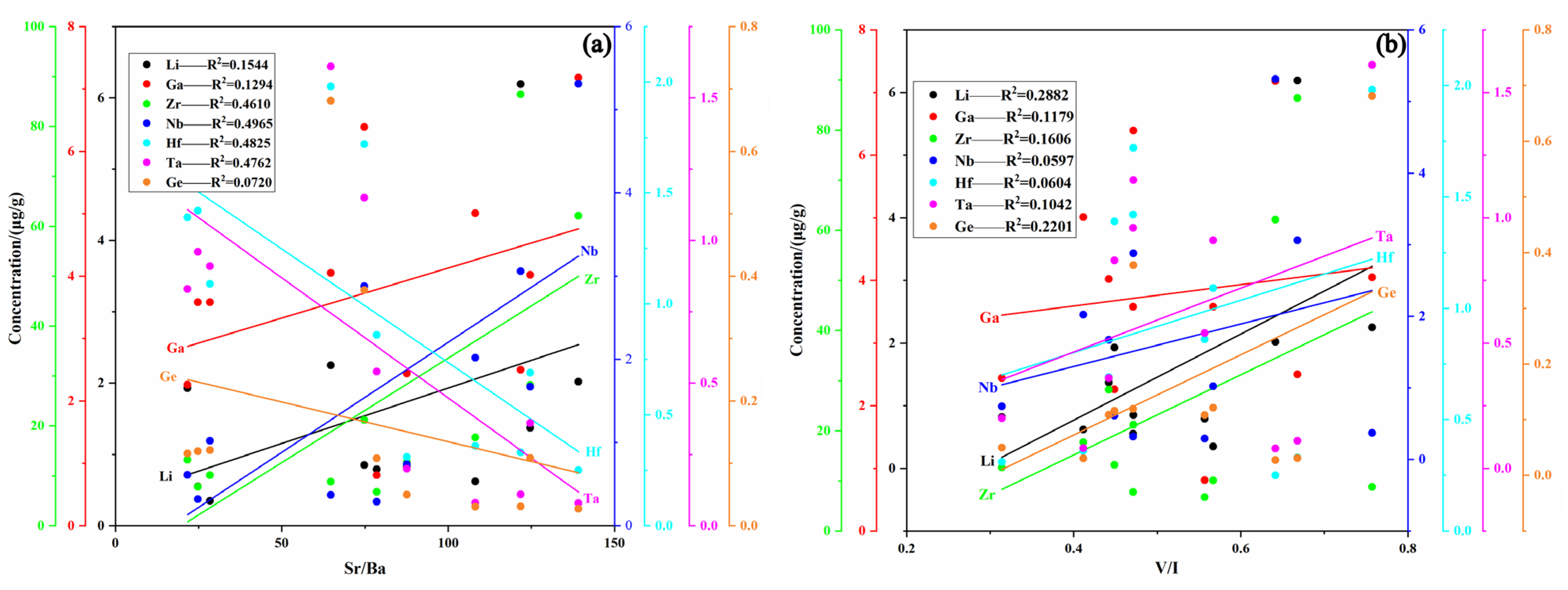
| Samples | Mad | Ad | Vdaf | FCd | St,d | V | I | L | Mi | Ro,max |
|---|---|---|---|---|---|---|---|---|---|---|
| Dnh-1 | 18.70 | 18.19 | 47.18 | 43.21 | 0.16 | 36.80 | 55.10 | 7.10 | 1.00 | 0.42 |
| Dnh-2 | 17.39 | 9.05 | 35.82 | 58.37 | 0.15 | 39.60 | 52.30 | 7.50 | 0.60 | 0.45 |
| Dnh-3 | 24.64 | 6.63 | 50.24 | 46.46 | 0.23 | 28.40 | 63.30 | 6.40 | 1.90 | 0.36 |
| Dnh-4 | 26.06 | 6.29 | 45.97 | 50.64 | 0.16 | 26.80 | 65.10 | 6.80 | 1.30 | 0.44 |
| Dnh-5 | 24.03 | 6.09 | 38.31 | 57.93 | 0.11 | 30.50 | 64.70 | 4.80 | 0.00 | 0.32 |
| Dnh-6 | 22.68 | 6.79 | 38.78 | 57.06 | 0.10 | 32.80 | 58.90 | 7.40 | 0.90 | 0.37 |
| Dnh-7 | 27.89 | 6.27 | 49.19 | 47.62 | 0.18 | 34.70 | 61.20 | 3.20 | 0.90 | 0.41 |
| Dnh-8 | 18.63 | 9.77 | 43.84 | 50.67 | 0.16 | 29.70 | 67.20 | 2.10 | 1.00 | 0.39 |
| Dnh-9 | 24.06 | 6.12 | 42.42 | 54.06 | 0.30 | 22.60 | 72.00 | 3.90 | 1.50 | 0.37 |
| Dnh-10 | 25.63 | 4.30 | 45.19 | 52.45 | 0.24 | 29.20 | 62.00 | 6.80 | 2.00 | 0.39 |
| Dnh-11 | 24.19 | 10.37 | 44.37 | 49.86 | 0.22 | 35.40 | 55.20 | 8.30 | 1.10 | 0.42 |
| Average | 23.08 | 8.17 | 43.76 | 51.67 | 0.18 | 31.50 | 61.55 | 5.85 | 1.11 | 0.39 |
| Samples | SiO2 | Fe2O3 | Al2O3 | CaO | MgO | K2O | Na2O | MnO | TiO2 | P2O5 | LOI |
|---|---|---|---|---|---|---|---|---|---|---|---|
| Dnh-1 | 9.06 | 0.22 | 3.96 | 1.25 | 0.34 | 0.03 | 0.40 | 0.01 | 0.31 | 0.01 | 84.41 |
| Dnh-2 | 2.59 | 0.11 | 1.58 | 1.59 | 0.45 | 0.03 | 0.38 | 0.01 | 0.04 | 0.03 | 93.20 |
| Dnh-3 | 1.74 | 0.18 | 1.27 | 1.09 | 0.35 | 0.02 | 0.41 | 0.01 | 0.05 | 0.01 | 94.89 |
| Dnh-4 | 1.35 | 0.43 | 0.77 | 1.18 | 0.36 | 0.04 | 0.38 | 0.01 | 0.07 | 0.00 | 95.42 |
| Dnh-5 | 1.38 | 0.20 | 0.88 | 1.40 | 0.42 | 0.02 | 0.31 | 0.01 | 0.03 | 0.00 | 95.35 |
| Dnh-6 | 1.54 | 0.12 | 0.95 | 1.54 | 0.44 | 0.03 | 0.30 | 0.01 | 0.03 | 0.00 | 95.04 |
| Dnh-7 | 0.55 | 1.85 | 0.46 | 1.05 | 0.36 | 0.03 | 0.29 | 0.03 | 0.04 | 0.00 | 95.34 |
| Dnh-8 | 3.49 | 0.22 | 1.57 | 1.48 | 0.42 | 0.03 | 0.42 | 0.01 | 0.12 | 0.00 | 92.24 |
| Dnh-9 | 1.32 | 0.36 | 0.80 | 1.38 | 0.40 | 0.03 | 0.42 | 0.01 | 0.05 | 0.00 | 95.23 |
| Dnh-10 | 0.32 | 0.60 | 0.42 | 1.27 | 0.39 | 0.02 | 0.37 | 0.01 | 0.03 | 0.00 | 96.58 |
| Dnh-11 | 2.24 | 2.66 | 1.17 | 1.08 | 0.36 | 0.04 | 0.43 | 0.05 | 0.10 | 0.01 | 91.88 |
| Average | 2.32 | 0.63 | 1.26 | 1.30 | 0.39 | 0.03 | 0.37 | 0.01 | 0.08 | 0.01 | 93.60 |
| Avg-C | 8.47 | 4.85 | 5.98 | 1.23 | 0.22 | 0.19 | 0.16 | 0.015 | 0.33 | 0.09 | -- |
| Samples | LREY (μg/g) | MREY (μg/g) | HREY (μg/g) | L/M | L/H | M/H | (La/Lu)N | (La/Sm)N | (Gd/Lu)N | δCe | δEu |
|---|---|---|---|---|---|---|---|---|---|---|---|
| Dnh-1 | 33.48 | 19.11 | 4.48 | 1.75 | 7.47 | 4.27 | 0.42 | 0.67 | 0.45 | 1.06 | 0.82 |
| Dnh-2 | 56.23 | 7.83 | 1.40 | 7.18 | 40.14 | 5.59 | 5.23 | 3.65 | 1.06 | 0.81 | 0.81 |
| Dnh-3 | 16.40 | 9.12 | 1.90 | 1.80 | 8.63 | 4.80 | 0.50 | 0.53 | 0.62 | 1.07 | 0.79 |
| Dnh-4 | 19.49 | 11.99 | 2.66 | 1.63 | 7.33 | 4.51 | 0.47 | 0.59 | 0.60 | 1.15 | 0.84 |
| Dnh-5 | 24.73 | 10.20 | 2.13 | 2.42 | 11.61 | 4.79 | 0.79 | 0.72 | 0.73 | 1.17 | 0.90 |
| Dnh-6 | 12.11 | 7.00 | 1.43 | 1.73 | 8.49 | 4.91 | 0.40 | 0.40 | 0.69 | 1.17 | 0.79 |
| Dnh-7 | 11.04 | 8.13 | 1.94 | 1.36 | 5.69 | 4.19 | 0.33 | 0.62 | 0.43 | 1.12 | 0.86 |
| Dnh-8 | 24.60 | 12.46 | 2.76 | 1.97 | 8.91 | 4.51 | 0.55 | 0.81 | 0.51 | 1.06 | 0.85 |
| Dnh-9 | 17.25 | 9.45 | 1.84 | 1.83 | 9.39 | 5.14 | 0.69 | 0.62 | 0.82 | 1.07 | 0.80 |
| Dnh-10 | 8.18 | 7.55 | 1.41 | 1.08 | 5.82 | 5.37 | 0.32 | 0.38 | 0.70 | 1.09 | 0.79 |
| Dnh-11 | 45.08 | 21.51 | 4.43 | 2.10 | 10.18 | 4.86 | 0.67 | 0.64 | 0.75 | 1.11 | 0.78 |
| Average | 24.42 | 11.30 | 2.40 | 2.26 | 11.24 | 4.81 | 0.94 | 0.88 | 0.67 | 1.08 | 0.82 |
| Samples | Li2O | Ga | Ge | (Nb, Ta)2O5 | (Zr, Hf)2O5 | REO |
|---|---|---|---|---|---|---|
| Dnh-1 | 190.90 | 13.74 | 0.17 | 40.02 | 1094.91 | 377.18 |
| Dnh-2 | 139.41 | 11.60 | 7.52 | 50.22 | 273.68 | 867.03 |
| Dnh-3 | 163.20 | 34.06 | 1.74 | 49.84 | 505.02 | 496.64 |
| Dnh-4 | 55.31 | 79.66 | 0.48 | 76.69 | 659.52 | 653.19 |
| Dnh-5 | 78.25 | 104.85 | 6.19 | 151.86 | 863.70 | 731.00 |
| Dnh-6 | 65.27 | 11.93 | 1.59 | 28.07 | 257.74 | 363.65 |
| Dnh-7 | 31.33 | 57.11 | 1.94 | 70.71 | 409.99 | 405.31 |
| Dnh-8 | 78.67 | 41.15 | 1.11 | 47.72 | 679.10 | 490.12 |
| Dnh-9 | 75.13 | 39.85 | 0.82 | 35.26 | 487.96 | 560.41 |
| Dnh-10 | 71.71 | 83.20 | 2.77 | 68.32 | 491.58 | 480.34 |
| Dnh-11 | 109.31 | 69.25 | 0.26 | 119.37 | 1381.10 | 823.43 |
| Average | 96.23 | 49.67 | 2.24 | 67.10 | 645.84 | 568.03 |
Disclaimer/Publisher’s Note: The statements, opinions and data contained in all publications are solely those of the individual author(s) and contributor(s) and not of MDPI and/or the editor(s). MDPI and/or the editor(s) disclaim responsibility for any injury to people or property resulting from any ideas, methods, instructions or products referred to in the content. |
© 2024 by the authors. Licensee MDPI, Basel, Switzerland. This article is an open access article distributed under the terms and conditions of the Creative Commons Attribution (CC BY) license (https://creativecommons.org/licenses/by/4.0/).
Share and Cite
Wang, R.; Wang, W.; Lu, Q.; Zhang, J.; Wang, W.; Dong, L. Geochemistry of Middle Jurassic Coals from the Dananhu Mine, Xinjiang: Emphasis on Sediment Source and Control Factors of Critical Metals. Minerals 2024, 14, 767. https://doi.org/10.3390/min14080767
Wang R, Wang W, Lu Q, Zhang J, Wang W, Dong L. Geochemistry of Middle Jurassic Coals from the Dananhu Mine, Xinjiang: Emphasis on Sediment Source and Control Factors of Critical Metals. Minerals. 2024; 14(8):767. https://doi.org/10.3390/min14080767
Chicago/Turabian StyleWang, Ruoyu, Wenfeng Wang, Qingfeng Lu, Jiaming Zhang, Wenlong Wang, and Lingling Dong. 2024. "Geochemistry of Middle Jurassic Coals from the Dananhu Mine, Xinjiang: Emphasis on Sediment Source and Control Factors of Critical Metals" Minerals 14, no. 8: 767. https://doi.org/10.3390/min14080767
APA StyleWang, R., Wang, W., Lu, Q., Zhang, J., Wang, W., & Dong, L. (2024). Geochemistry of Middle Jurassic Coals from the Dananhu Mine, Xinjiang: Emphasis on Sediment Source and Control Factors of Critical Metals. Minerals, 14(8), 767. https://doi.org/10.3390/min14080767









